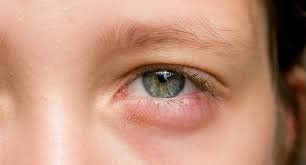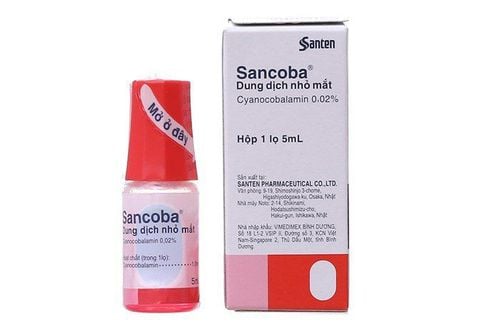This is an automatically translated article.
Melevo medicine has the main ingredient Levofloxacin and other excipients in a sufficient amount. It is used for the topical treatment of infections of the external structures of the eye and the surrounding area caused by organisms sensitive to Levofloxacin. Specifically, the drug works to treat conjunctivitis, eyelid inflammation, keratitis, stye; Prevention and treatment of infections after eye surgery.
1. What is Melevo?
Melevo is prepared in the form of eye drops, a clear, colorless to pale yellow solution. Box of 1 bottle of 5ml.
Drug group: Antiparasitic, anti-infective, antifungal and antiviral drugs.
Dosage form: Solution for eye drops.
Packing: Box includes 1 bottle of 5 ml.
Ingredients: Each 5ml vial contains the active ingredient Levofloxacin in the form of Levofloxacin hemihydrate 25mg.
1.1. Pharmacodynamics of pharmaceutical substances Levofloxacin is an antibiotic belonging to the Quinolone group, which is an infusion isomer of Ofloxacin that is tens to hundreds of times stronger than detrofloxacin, depending on different bacteria. The mechanism of action of Levofloxacin and other Fluroquinolone antibiotics is to inhibit topoisomerase IV and DNA gyrase (both type II topoisomerases), enzymes required for DNA synthesis, replication, and recombination of DNA. bacteria.
In vitro, the active ingredient Levofloxacin has a broad spectrum of activity against Gram-positive and Gram-negative bacteria, the concentration of which has a bactericidal effect equal to or higher than the inhibitory concentration of bacteria.
Bacterial strains sensitive to drugs such as sua:
Gram-positive aerobic bacteria: Staphylococcus aureus, Enterococcus faecalis, S. pneumoniae, Streptococcus pyogenes... Gram-negative aerobic bacteria: Escherichia coli, Proteus mirabilis, Haemophilus influenzae, Klebsiella pneumoniae, Enterobacter cloacae, Legionella pretrophila, Moraxella catarrhalis, Pseudomonas aeruginosa... Other bacteria: Mycoplasma pneumoniae and Chlamydia pneumoniae. 1.2. Pharmacokinetics of the drug There are no specific studies on the extent of systemic absorption from Levofloxacin ophthalmic solution. However, systemic absorption may occur with Melevo ophthalmic. If the maximum dose of Melevo is given during the first 48 hours (2 drops in each eye every 2 hours) systemic absorption occurs very rarely.
1.3. Active ingredient Levofloxacin is a synthetic antibiotic belonging to the Quinolone group, an isomer of Ofloxacin and is more active than Ofloxacin. The mechanism of action of the active ingredient Levofloxacin is to inhibit DNA synthesis, so it prevents the processes of DNA replication, replication, repair, recovery and recombination of bacteria. In vitro, the active ingredient Levofloxacin has a broad spectrum of activity against many strains of Gram-negative and Gram-positive bacteria. There is usually no cross-resistance between Levofloxacin and other antibiotics in this class.
2. What disease does Melevo treat?
Melevo is indicated for the treatment of the following conditions:
Local treatment of infections of the external structures of the eye and the surrounding area caused by bacteria sensitive to Levofloxacin, in particular conjunctivitis, keratitis, eyelid inflammation or stye. Prophylaxis and treatment of infections after eye surgery.
3. Usage and dosage of the drug Melevo
3.1. How to use the drug Melevo Melevo is used in the form of eye drops.
3.2. Dosage of the drug Melevo Day 1 and day 2: Instill from 1 to 2 drops x 2 hours / time, instill no more than 8 times / day. Day 3 to day 7: Apply 1 to 2 drops x 4 hours/time, no more than 4 times/day. Close the lid after use. Use Melevo within 30 days after first opening. Note: The above treatment dose is for reference only. The specific treatment dose depends on the health status and severity of the disease for each person. To get the right therapeutic dose, you need to consult your doctor or medical professionals.
4. In case of over/forgotten dose
In case of overdose: An overdose of eye drops containing the active ingredient Levofloxacin has rarely occurred. Overdose symptoms are similar to those of drug side effects. In case of an overdose, the doctor will instruct you to rinse your eyes with warm water. Missed dose: If you miss a dose, you should try to take it again as soon as possible. However, if it is almost time for your next dose, skip the missed dose and take your next dose at the scheduled time. Note that you should not instill more than double the prescribed dose.
5. Undesirable effects of the drug Melevo
When using Melevo, you may experience unwanted effects, including:
Temporary loss of vision, very transient feeling, eye pain, discomfort, burning, redness or swelling of the eyes. , eyelids, lacrimation, sensation of tightness in the eyes, dry eyes and increased sensitivity to light. Fever, severe headache, sore throat. Instructions on how to manage unwanted effects: If you have any of the above symptoms after treatment with Melevo, the right thing to do is to stop using the drug. You should also proactively inform your doctor about unwanted effects encountered when using the drug.
6. Interactions of Melevo
There are currently no adequate interaction studies with eye drops containing Levofloxacin. The fixed plasma concentration of Levofloxacin after ophthalmic administration is 1000 times lower than that of oral administration, therefore, interactions with systemic administration are not significant when using Melevo ophthalmic. If used concurrently with other eye drops, you should instill 2 types at least 15 minutes apart.
7. Some notes when using Melevo
Before using Melevo, you need to carefully read the instructions for use and refer to the information below.
7.1. Contraindications of the drug Melevo is contraindicated in the following cases:
People with a history of hypersensitivity or hypersensitivity to Levofloxacin components, other Quinolone antibiotics or any ingredient of the drug. Do not inject the drug into the eye. Do not inject the drug under the conjunctiva, do not let the drug come into contact with the anterior chamber of the eye. 7.2. With other antibiotic preparations, prolonged use may lead to overgrowth of non-susceptible microorganisms, including fungi. If superinfection is present, appropriate therapy should be initiated when multiple prescriptions are required or whenever clinical examination is necessary, you should be examined with the aid of magnifying instruments such as a slit lamp and as needed. fluorescent pre-staining. You should not wear contact lenses if you have signs and symptoms of bacterial conjunctivitis. Use in Children: Safety and effectiveness in children under 1 year of age have not been established. Ability to drive and use machines: After taking Melevo, vision may be temporarily unstable. You should not drive, use machinery, or do any activity that requires clear vision, until you are sure you can do these activities safely. Pregnancy: Melevo eye drops should be used during pregnancy only after the potential benefit outweighs the risk to the fetus. Lactation: Levofloxacin is not known to be excreted in human milk. Therefore, you should temporarily stop breastfeeding while using Melevo or change other drugs. Above is the complete information about the drug Melevo. For safety, you need to read the user manual carefully before use.
Please dial HOTLINE for more information or register for an appointment HERE. Download MyVinmec app to make appointments faster and to manage your bookings easily.













